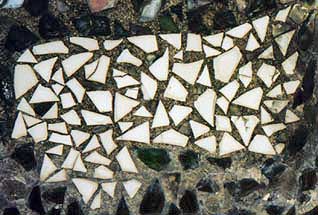What does "pique assiette" mean?
 The term "pique assiette" for a mosaic of broken
crockery originates in the activities of Raymond Isidore of Chartres,
northern France, who became known by the name "Picassiette".
In 1930s France, Isidore began the obsessive enrichment of his
entire property (inside and out) with intricate and decorative
mosaics of salvaged shards, and his house came to be called La Maison Picassiette
The term "pique assiette" for a mosaic of broken
crockery originates in the activities of Raymond Isidore of Chartres,
northern France, who became known by the name "Picassiette".
In 1930s France, Isidore began the obsessive enrichment of his
entire property (inside and out) with intricate and decorative
mosaics of salvaged shards, and his house came to be called La Maison Picassiette
 The nickname he was given suggests that his neighbours were not enthusiastic about his achievements. In French, a "pique-assiette"
is a scrounger, sponger or gatecrasher, someone whose interest
in stealing a plate would generally be the food on it.
The nickname he was given suggests that his neighbours were not enthusiastic about his achievements. In French, a "pique-assiette"
is a scrounger, sponger or gatecrasher, someone whose interest
in stealing a plate would generally be the food on it.
"Picassiette" may well be a pun on "Picasso",
while "piqué" can mean "crazy" or
"nuts". Despite this early disdain, 30,000 people
a year visit "La Maison Picassiette" these days, and
the term "pique assiette" is used around the world.
It's an interesting thought that perhaps the way this nickname
was invented was unconsciously mimicking what Isidore was doing.
It took pieces of language, broke them up and created something
new, just as he did with crockery.
 La Maison Picassiette is often quoted as an example of "outsider
art" or "art brut", because Isidore had no artistic
training or connection with the art world. Pique assiette mosaic
has found a place in the work of other outsider artists too. Certainly
the materials are generally inexpensive and accessible, and their
durability has allowed the creation of visionary constructions
such as:
La Maison Picassiette is often quoted as an example of "outsider
art" or "art brut", because Isidore had no artistic
training or connection with the art world. Pique assiette mosaic
has found a place in the work of other outsider artists too. Certainly
the materials are generally inexpensive and accessible, and their
durability has allowed the creation of visionary constructions
such as:
The Little Chapel, Guernsey, Channel Islands
Nek Chand's Rock Garden, Chandigarh, India
Gaudi's architectural scale and Isidore's mosaic modification of his personal environment are reflected in other large scale projects such as:
the Tarot Garden, Capalbio, Italy
Bruno Weber's Weinrebenpark, Dietikon, Switzerland web site (in German) [translation] another article
Jean Linard's Cathedral, Bourges, France
the monumental installations of Isaiah Zagar, Philadelphia
the House of Shards, Louisiana
More about pique assiette: pique assiette and found objects
the joy of shards Mosaics Resource